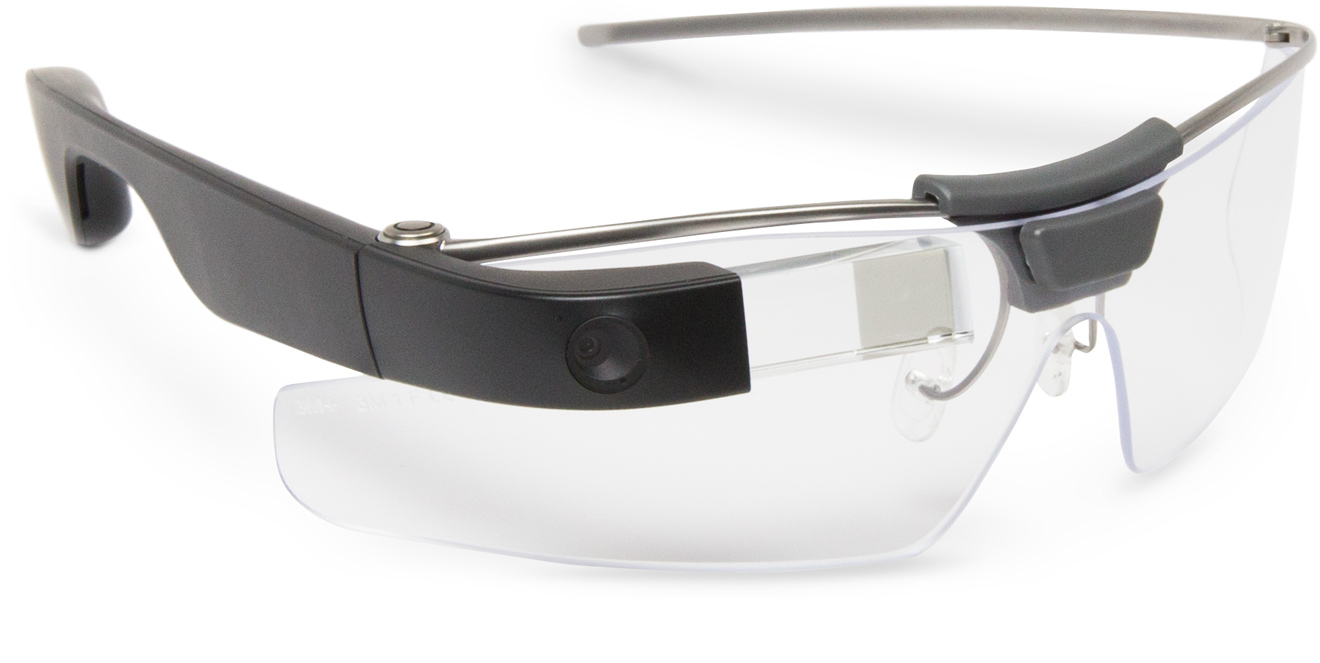AUGMENTED REALITY
Google Glass Returns, and This Time It’s Meant for Business
When we go to see the doctor there are a few pieces of equipment we expect to see: a stethoscope, a tongue depressor, a blood pressure cuff, but could Google Glass frames be the next tool no doctor can be seen without? Daniel Davies look at how the technology once meant for consumers has changed the doctor’s surgery forever
Dr David Demarco, a physician at Northcreek Family Practice in Cincinnati, Ohio, explains how patient examinations have changed since he started using Google Glass. “I go into an exam room with a patient wearing a Glass unit, and just interact with the patient as I always would. What's happening is there's an audio and video stream that’s going to a scribe who is in a secure location off site. I currently work with a scribe in San Francisco, while I'm in Cincinnati, Ohio, and we're remotely connected. They’re hearing and getting a general visual picture of what's going on as I interact with the patient, and then they are documenting in real time what they see and what they hear,” says Demarco.


Phoebe Hugh, CEO, Brolly
“When I leave the room I make a few details about what was abnormal on an exam or maybe what a plan will be moving forward to treat the patient. The scribe then finishes that note and usually within fifteen minutes or so there is a note ready for me to review and sign, and I make any edits that are necessary, but in essence they've been writing the note while I'm seeing the patient and I make very small edits. We close the note and move onto the next patient.”
This could be the future of healthcare, where scribes in secure locations remove the burden of administration from overworked doctors. But even if we can’t be sure that doctors, medical practices and patients will be as comfortable using Glass as Demarco is, what we can be sure of is that this is the future of Google Glass. The product that was originally going to change the way normal people experience the world has been forced to get a job and will now be seen in industries from healthcare to manufacturing.
When Glass was announced in 2012, it was launched with an accompanying snazzy video titled ‘Project Glass: One day’, which showed a concept for Google Glass where it could play music, transcribe and send messages, optimise travel routes in real time and take pictures and videos of anything the user was looking at. In short, Google’s vision for Glass was for it to add real value to people’s lives.
People loved the concept; it was featured in Vogue’s future of fashion issue, celebrities turned up to award shows wearing it and college courses were devised in its honour. However, the technology’s early, halcyon days were short-lived. Headlines like ‘Goggle Glass: is it a threat to our privacy?’ started to appear in the national press (this one is from the Guardian), and users were shunned and dubbed ‘Glassholes’ because of panic induced by the thought that Google Glass wearers may foist the technology, and in particular its ability to capture pictures and film, onto unsuspecting members of the public. Eventually, Google acquiesced to its detractors’ concerns and Glass was placed on indefinite hiatus in January 2015.
Unbeknown to the public that Google had originally attempted to court, Glass wasn’t gone; it had merely been placed on a different path that would end with the creation of Google Glass Enterprise Edition. This version wouldn’t attempt to be all things to all people. Instead, the new version would be limited so that it was only capable of completing tasks needed for specific roles. For example, in the case of Demarco, his version is restricted to recording video and audio. The tech wasn’t completely stripped back though, so the new Enterprise Edition features faster and more reliable Wi-Fi, extended battery life and a faster processor than its consumer predecessor. The camera was also upgraded from five megapixels to eight, and, importantly for anyone coming into contact with Glass in the future, a green light now goes on when video is being recorded. It’s because of this new, business-specific version, that professionals like Demarco became interested.
“There was intrigue in maybe this would be a way to improve both patient care and physician satisfaction,” says Demarco. “We got into negotiations with Augmedix [who provide the new Enterprise Edition to healthcare professionals] to start a pilot project with a handful of us: five primary care doctors and four orthopaedic doctors in March 2015. We did this as an initial six-month pilot where just these doctors worked with the product and worked all the bugs out of it, which were very few, but it was quite helpful in terms of the physician satisfaction and the patient experience. Then our system began introducing it to more and more providers who were interested in using it.”
Making interactions with doctors more personal
To get a feel for what Enterprise Edition has done for Demarco and other healthcare professionals, you have to understand what his job previously entailed. Before Glass entered his surgery, Dermarco explains that his interactions with patients were intercut with him interacting with his computer, so while he was talking to a patient his back could be turned to them and his eyes could be fixed on a computer screen, which, as he acknowledges, “is a bit impersonal”.
The second thing Demarco had to take care of was completing the patient’s note after they had left. “You have to go and write everything that they said that was pertinent and you have to write down all your exam findings and write your plan and that just takes a lot of time, and a lot of doctors end up doing that after hours, as opposed to doing it during the clinic, because otherwise you get bogged down and you get very far behind, and there's a patient satisfaction concern when you're running an hour behind schedule.”
Google Glass Enterprise Edition has put paid to these issues because his scribes, who for the most part are people who have aspirations of becoming medical providers themselves, take care of the admin work, which leaves doctors free to take care of patients’ comfort and care.
“I'd say after about six months I was convinced it was the right approach.”
But despite the obvious benefits, Demarco explains he wasn’t immediately convinced by the tech’s usefulness, and it took about six months for him to be sure that Enterprise Edition was a tool that he wanted to continue using.
Now that the initial getting-to-know-you period has passed though, he couldn’t imagine going back to his traditional, back-turned-to-patients method. “At this point it'd be very hard for me to go back to the old method, simply because I've built work flows around this and it's been more efficient,” says Demarco. “I'd say after about six months I was convinced it was the right approach.”
Demarco describes himself as an “early adopter”, and while using the technology is now second nature to him, the decision on whether to use Google Glass or not is voluntary within his umbrella, healthcare service, TriHealth, so physicians who aren’t as comfortable with technology can opt not to test the technology. To the naysayers, Demarco urges them to commit to a six-month trial, and believes spending that length of time using Glass will convert even the most technophobic physicians. However, he has heard of a couple of people who started using the technology but for one reason or another stopped, so as attractive as he technology sounds it’s clearly not for everyone.

It’s not about the person wearing it
The last time we all got excited about Glass, it didn’t fail because the people using it didn’t like it or couldn’t see its potential (although there were some complaints that early iterations of the technology were buggy), the real problem Glass faced emerged when it began to interact with an unsuspecting world.
Take the example of Sarah Slocum, who used the consumer version of Glass in a San Francisco bar back in 2013. Slocum claimed that while demoing her Google Glass frames to the bar's curious patrons she was assaulted, but thanks to the tech’s video feature she was able to record the incident and post it on YouTube. “This is the first video that I took on Google Glass at Molotov bar...after being verbally accosted and flipped off by the Asian looking woman,” Slocum wrote in the video’s description. “I was hoping that by turning on the video I would either catch their threatening and hateful behaviour... presuming that if I started recording them and told them what I was doing they would stop verbally accosting and threatening me for wearing Google Glass. However, instead it only further provoked them.”
“A lot of people think the technology's cool and they like the idea that their doctor is using something more than just traditional means to take care of them.”
Wearing the enterprise edition of Glass in the course of your work as a doctor is clearly different to taking the consumer version, which doubled as a recording device, to a local bar, but the point remains that the success or failure of Glass will probably come down to how other people react to it. Demarco says that in the time he’s been using the tech he’s encountered little resistance to Glass, so far.
“The acceptance rate is somewhere around 98%,” says Demarco “There is a rare occasion where a patient says, I'm just not comfortable, I don't feel like I want anyone else interacting with me in this encounter, and we just take the Google Glass off and we go in and see the patient in the traditional way, and that's fine.
“I know the usual patients that don't want it and it's not an issue we just don't even bring it up with them, but for everyone else there's been no dissatisfaction whatsoever. I think they like that I spend more face-to-face time with them [and] it's more personal. I joke around with them more than I used to because I have time to do so, and then also a lot of people think the technology's cool and they like the idea that their doctor is using something more than just traditional means to take care of them.”
Does it always have to be for the workplace?
If Demarco and his patients are anything to go by then it appears that Google Glass Enterprise Edition will succeed where Google’s consumer version failed. But as the technology gains fans in the workplace, will the day ever come where Google U-turns and Glass becomes a consumer product once again?
In an interview with tech commentator Steven Levy, Google denied that it was surreptitiously trying to reintroduce its Google Glass project before it begins another assault on the consumer market, but did say that it wants to get Glass into the hands of as many people as possible. “None of us have given up on the idea that over time Glass will become less and less intrusive, and that more and more people will use it,” said Astro Teller, who runs Google’s X division. “But we're not going to prejudge exactly what that path is—that's where we went wrong last time. We’ll focus on the places that are actually getting value out of that and go through the journey with them, being open-minded about where it's going to go.”
Demarco though doesn’t dream of a future where he can respond to messages or manoeuvre around the streets of Cincinnati using Glass; he is more than happy to take it off and leave it in the office, where Glass belongs; for now. “Personally, I wear it enough and I'm done with it by the end of the day, so I’m glad to take it off by the time the work day is over. It's a great work tool for me, but I would be less inclined to use it in my personal life,” says Demarco.

First inline image courtesy of X Development
All other images courtesy of Augmedix